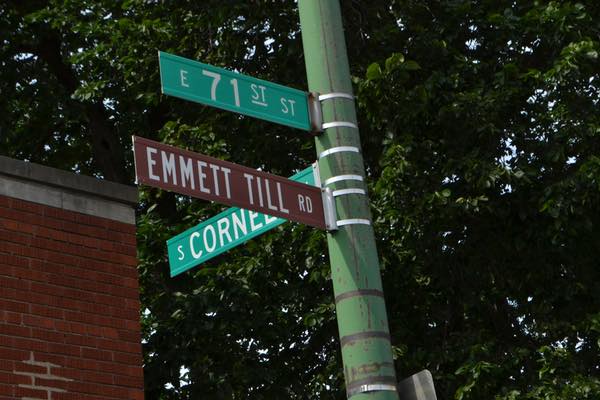
In August of 1955 Emmett Till was lynched. A native of Chicago, the 14-year old was visiting relatives on the Mississippi Delta. While shopping at a local family-owned grocery store, Till was accused of offending a white woman. Several nights later, he was abducted from the home of his great uncle, tortured, and then murdered. His body was thrown into the Tallahatchie River.
Emmett Till’s bloated and mutilated corpse was returned to Chicago for burial. His mother insisted that the casket remain open so that the nation could see what happened to her son. Tens of thousands attended the funeral and viewed the macabre and frightening remains of a once vibrant and healthy young black man. Black-oriented newspapers and magazines published the grotesque image, rallying black support and white sympathy across the nation and the world.
I was 10 years old in 1955. I still remember seeing the image of Emmett Till’s body in Jet Magazine. That image has been etched in my memory to this day.
Since then there have been many iconic depictions of the struggle of black Americans for equality. Who can forget the image of Rosa Parks sitting on a bus in Montgomery, Alabama, in December of 1955, just months after Emmett Till’s death; police dogs attacking peaceful demonstrators in the 1960s; the image of the 1963 bombing of the Birmingham church where four black schoolgirls were killed; and most recently, Colin Kaepernick taking a knee at a NFL game?
In the early afternoon of May 25, I turned on my television. I anticipated the usual CNN updates on the COVID-19 virus. But what I saw, like the image of the body of Emmett Till, was an image that will remain in my mind forever. I saw for the first time George Floyd on the ground with a police officer kneeling on his neck as he begged for the right to breathe.
Emmett Till’s death became a catalyst for the Civil Rights Movement. After two weeks of demonstrations, it appears that George Floyd’s death has jump started the once largely black movement for civil rights into a national, multiracial, multicultural movement that looks to change America and particularly the way we police Americans and deal with police misconduct. It appears that millions of Americans of all races have finally gotten the message — Black Lives Matter.
It is a sad reflection on American life that in 2020, even as millions of people demonstrate for change, the vestiges of the mindset that lead to the deaths of Emmett Till and George Floyd still exist in the society. Stoked by the voice in the White House, hatred is still evident in our society. The rotten underbelly of American society has come out from under its sheets — racist posts on social media; the 2015 killing of nine black parishioners in a Charleston, South Carolina church; the 2018 massacre of 11 Jewish worshippers in a Pittsburg synagogue; the white woman in a New York City park who called the police on a black man when he asked her to put her dog on a leash.
In January of 2019, legislation was introduced in the House of Representatives to amend the United States Criminal Code to specify lynching as a hate crime. It passed the House 410-4. The bill was entitled the Emmett Till Antilynching Act. When the bill moved on to the Senate, objections of one Republican, Senator Rand Paul of Kentucky, have succeeded in preventing the bill from becoming law.
The defeating of antilynching and civil rights legislation has been a vocation and avocation of many southern politicians since the end of the Civil War. What happened to Emmett Till and George Floyd and the untold number of victims of racism and police brutality, and an unequal justice system are a part of their legacy. Paul stands on their shoulder alongside generations of so-called white liberals who were more concerned about keeping their seats in Congress than standing up for the rights of minorities.
Perhaps white Americans finally understand what black Americans have been saying since Emancipation — we just want equality. As the Rev. Al Sharpton said in his eulogy of George Floyd, all we want is to get your knee off our necks so that we can be like the rest of America.
Hopefully, the iconic photo of George Floyd’s death has ripped the scab off the festering wound of racism that has long infected this nation. We can only hope that those who demonstrate, and those who protest will be the balm that heals the wound that has festered in this nation far too long.
To honor George Floyd’s memory, every American who has demonstrated in support of his cause or wanted to demonstrate will vote on November 3. That will send a message to those who continue to hate and allow us to feel that George Floyd and Emmett Till did not die in vain.

C. Ellen Connally is a retired judge of the Cleveland Municipal Court. From 2010 to 2014 she served as the President of the Cuyahoga County Council. An avid reader and student of American history, she serves on the Board of the Ohio History Connection, is currently vice president of the Cuyahoga County Soldiers and Sailors Monument Commission and president of the Cleveland Civil War Round Table. She holds degrees from BGSU, CSU and is all but dissertation for a PhD from the University of Akron.
One Response to “COMMENTARY: Till Black Lives Matter”
Larry Corman
For reasons probably to do with the horrific video of Mr. Floyd and the fact that Americans have had it with racist killings by the very people who are supposed to protect us.
I am encouraged by the diversity of the demonstrators and hope this is the time we break The continued racist killings by law enforcement. It will require not only training of police it the removal of a significant number of racist police